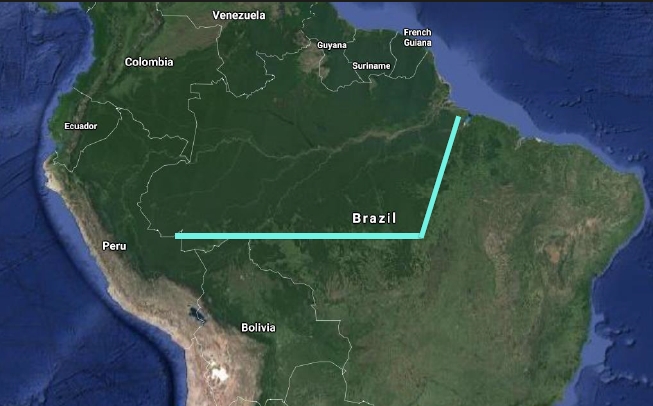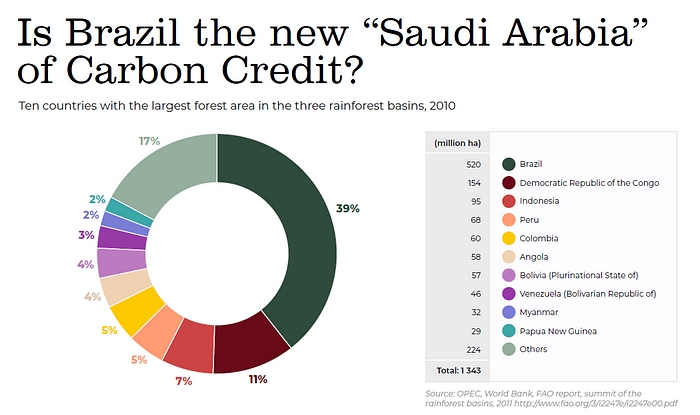White Paper
Moss Amazon Forest NFT: Own a token that represents a part of the Amazon forest and help to build the “Green Wall”
Own a token that is connected to a specific part of the Amazon Forest. The land, the trees, everything.
This is NOT just another game card or vehicle for raising money for conservation. None of that “buy this art to protect the forest” stuff.
This NFT carries rights related to the actual real estate.
Via your purchase of your piece of the Amazon Forest, you contribute to the creation of a “Green wall” of properties focused on conservation and acting as a deterrent to advancing deforestation.
Moss has calculated that, with a 15 million hectare “Green Wall”, we can deter deforestation in the Amazon. That would probably cost US$ 10 billion. We have sourced most of the needed land for that “green wall.”
Forests with sound legal and environmental standing
Moss has conducted rigorous due diligence to select the best forests in the Amazon, with rock solid legal and environmental standing.
Your hectare of Amazon Forest, a click away
No bureaucracy or red tape for you: Moss has taken care of it all and will act as a custodian for local authorities and notary offices, free of charges.
State of the art satellite monitoring and protection
Moss has partnered with Descartes Labs to provide state of the art satellite imagery, updated every 6 days, with the highest resolution available in the market, and available to all NFT owners. These third party, independent partners will be responsible for MRV (Measuring, Reporting, Verification), and Moss will hire and manage the contracts.
The company will direct 20% of sales proceeds to a 30 year protection fund that will cover patrolling and maintenance of protection activities.
One share = one hectare = one football field worth of your OWN piece of the Amazon Forest
We have issued one NFT per hectare, that’s a football field of real forested land with a permanent preservation duty.
Google link for the area: https://www.google.com/maps/d/u/0/viewer?hl=pt-BR&ll=-9.168985453128698%2C-56.4344615&z=16&mid=1O8KvtdQRpI_vxjq1IVUbY38-6Gjz1pdI
More information on the NFTs, FAQ, governance matters: https://nft.moss.earth/
Our aim is to save the planet’s forests, beginning with its most famous one: the Amazon
As we have explained in our MCO2 token white paper, humanity is facing its largest challenge ever: climate change. The lack of alignment of our economic system with living in harmony with Nature, and the separation of civilization from our natural environment has led us to view Nature to be something to be conquered, exploited and defeated. This way of viewing the world, and especially, the non internalization of the externality of pollution and natural degradation (humanity not paying for the costs of destroying the planet and socializing these costs) have led to critical climate conditions.
We currently emit (or pollute) 55 gigaton of CO2 eq per year — this number was 25 gigaton as recently as 2008. If we continue to emit 55 gigaton per year in the next 10 to 15 years, scientists estimate that the impact on the planet will be dire: an increase of 3 degrees Celsius to the global average temperature by 2070. This rise in temperature would mean: rising tides flooding all the world’s areas by the ocean, food production dropping by more than 50% and the tropical zone of the world (Latin America, Africa, Southwest Asia, Middle East) becoming uninhabitable due to extreme temperatures.
How do we solve this problem? How do we align humanity’s interests with reducing emissions drastically? Tackling deforestation in tropical countries like Brazil is one of the main solutions. According to the Environmental Defense Fund, “tropical deforestation contributes about 20% of annual global greenhouse gas (GHG) emissions, and reducing it will be necessary to avoid dangerous climate change.”
China and the US are the world’s number one and two emitters, but numbers three and four are Indonesia and Brazil, with ~80% and ~70% of their emissions respectively from deforestation.
With the increase of the impact of climate change on our daily lives, many different initiatives have begun to develop a panacea of ways to reduce emissions and create incentives for people to make more money by reducing emissions:
Technologists have focused on carbon capture machines (CCMs) or the development of new technologies that accelerate the withdrawal of CO2 from the air, like microalgal cell biofactories. These are still unfortunately too expensive (US$ 1000 to US$ 500 per ton of CO2eq), but scaling rapidl
Some others have focused on technology substitutions, like electrification of transport (trains, cars, airplanes) and protein substitution (from animal to plant or synthetic based), which are also scaling rapidly. The aim here is to speed up the transition from a fossil energy based economy to a renewable one, and to reduce the impact of clearing lands for agriculture for feeding and animal flatulence — all great solutions for emission reduction.
Finally, there is a global system that internalizes the externality of GreenHouse Gas emissions and leads companies that pollute more to transfer money to companies that pollute less: the global carbon credit system. It is an intricate and complex system, with 65 different protocols, regulated and voluntary markets, that is still far behind its potential size. Nonetheless, companies like Moss have worked to improve this market via the use of blockchain and web 3.0 governance, and prices have begun to pick up (x 5 in last 2 years) and transactions have begun to become easier and to have lower friction.
We at Moss believe that people have to make money from conservation and emission reduction for us to act with the urgency we need.
People deforest in countries like Brazil because the forested area is worth significantly less than “cleared” land. In the Amazon Forest, one buys a forested hectare for US$ 100–400, slashes and burns, and resells above US$ 500. As long as this perverse logic continues, people will make money from deforestation, and they will burn all the world’s forests to the ground.
How do we invert this logic? We have to make the forested area be valued more than the “cleared” area for cattle grazing and agriculture.
How do we generate yield and economic benefits to conservation? There are many ways, like ecotourism, sustainable gathering (picking tropical fruit like acai and brazil nuts, for example), or sustainable forest management (cutting down older, specific trees in a planned way so as not to reduce the forest). We believe that the recent boom in carbon credits has created a new, strong incentive, which is the certification and sale of carbon credits from avoided deforestation (REDD+ and other avoided deforestation protocols).
We have seen the beginning of a “green gold rush” in the Amazon, and we intend to accelerate it and catalyze it via the use of cutting edge technology.
Here is the math behind the recent rush to buy forested land in the Amazon: avoided deforestation, once audited and certified, leads to a yield per hectare of 10 credits per year. At current prices of US$ 15, that is a yield per year, for 30 years, of US$ 150 per hectare (Amapa state average prices were R$ 1312 in 2019, or US$ 262, Amazonas was R$ 356, or US$ 70). Well, if one is buying these hectares at US$ 150 on average, and it takes 3 years to certify, that is a 4 year payback or 20–25% IRR. What would be a more reasonable yield? Let’s say 5%? That would mean that, keeping carbon credit prices constant, forested land prices would have to rise to US$ 600–750, leading forested land value to surpass the value of cleared land. Voila, we will have saved the forest, as no one in their right mind will buy land for US$ 600 to burn and resell for US$ 500.
At Moss we believe that a huge challenge and impediment to this logic above is the high cost of transacting forested land in Brazil.
Rule of law is weak, bureaucracy and corruption are rampant, and the lack of digitalization of processes leads to high friction, legal and transaction costs. Our contribution is to make forested land as expensive as possible, and thus to break the logic and profits behind current slash and burning. We believe that we have built a great system and product for seamless acquisition of Amazon forest for protection purposes. We have built an extensive due diligence process and consolidated Brazil’s several databases for checking of potential legal or ownership issues into a proprietary system that allows us to do in seconds the legal work that normally takes months. More importantly, we have put all the information of contracts, ownership, coordinates for the property, shape files, legal deed etc into smart contracts, and thus completely eliminating the risk of “double spending” (someone selling the same area more than once). We are buying the properties under a specific preservation scheme, connecting the real estate to NFTs, and selling them online — on our website and on NFT marketplaces like Opensea and Ariswap (Celo).
One is thus able to buy at the Moss website a token that is connected to a specific part of the Amazon Forest, on their credit card (crypto knowledge is not required), in a couple of clicks.
This ease of transacting has already led to massive appreciation of the first NFTs (each NFT represents one hectare, or a football field worth of forest) — prices for more expensively priced agricultural border forests are now at US$ 4,000 on the secondary NFT market. If we can spread this impact for the surrounding areas, we will save millions of forested hectares.
It is key to note that the NFTs could possibly have economic utility and due to market conditions appreciate over time. Not only through capital gains, but also, given the adequate regulatory environment, the potential generation and sale in the future of carbon credits generated by the conservation work. Furthermore, the NFTs have real assets backing them (real estate), thus can be bonded and offer yield farming via Defi solutions. Web 3.0 could lead to the creation of several solutions for the remuneration of the Amazon land plots.
The Green Wall
Saving the Amazon Forest, the world’s largest and most famous tropical forest, costs much less than people imagine. That is because one does not need to protect the whole 600 million hectares of forest: we should focus on protecting the threatened borders. There are no natural fires or disasters leading to deforestation, all loss of trees in the Amazon comes from human criminal activity. Thus, we at Moss have calculated the area we need to protect, and have found out it encompasses 15 to 20 million hectares.
THE GREEN WALL
Our goal is to build, with your help, a Green Wall of protection on the rims of the Amazon forest. We have sourced 1 million hectares of the 15 to 20 million necessary to build this wall. These properties are currently owned by large agricultural producers or private landowners.
We estimate the cost of acquiring this area to be of US$ 15 to US$ 20 billion tops, and are confident that, once the Green Wall is built, access to the inner part of the forest becomes prohibitive and we will drastically reduce deforestation (and thus GHG emissions). Please mind how little money is required: US$ 15 billion would be equivalent to a one off cost of less than 1% of Brazil GDP, or 0.015% of global GDP. Since Brazil holds more than 40% of the world’s tropical forests, if we solve the deforestation issue in Brazil, we can expand the solution to the rest of the world, and save the world’s forests.
BRAZIL HOLDS 50% OF THE WORLD’S CARBON RESERVE
JOIN US ON DISCORD AND FOLLOW US TO BUY YOUR NFT AND PARTICIPATE IN THE BUILDING OF THE GREEN WALL: https://discord.gg/usFYBFjS
#AmazonGreenWallClub
Last updated

